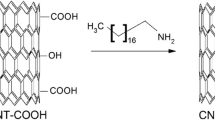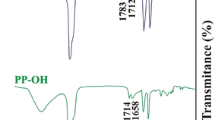Abstract
In situ emulsion polymerization was employed for synthesizing carbon nanotube (CNT) composites in a colloidal system with poly(styrene) or PS to form nanostructured brush. CNTs were initially functionalized with oleic acid, followed by silanization with (3-aminopropyl) triethoxysilane to impart cross-linking properties. Styrene monomers were efficiently grafted to surface modified CNT via emulsion polymerization with variable CNT concentrations. FTIR analyses of the functionalized CNT and PS/CNT composites confirmed the bond formation and effectiveness of the developed experimental method. X-ray photoelectron spectroscopy confirmed the presence of the desired bonds and the composition of the composites. Structural properties of the composites characterized by TEM confirmed excellent deagglomeration and dispersion of CNTs in PS/CNT composite. Thermal characteristics from TGA and DSC data showed enhanced properties for the nanocomposites as a function of the CNT content. BET measurements indicated significant improvements in surface area and pore volume with enhancements in gas sorption for the polymer nanocomposites.










Similar content being viewed by others
References
Ajayan PM, Linda SS, Braun PV (2003) Nanocomposite science and technology. WILEY-VCH, Weinheim, pp. 31–35
Azzaroni O (2012) Polymer brushes here, there, and everywhere: recent advances in their practical applications and emerging opportunities in multiple research fields. J Polym Sci A 50:3225–3258
Rastogi A, Paik MY, Tanaka M, Ober CK (2010) Direct patterning of intrinsically e-beam sensitive polymer brushes. ACS Nano 4:771–780
Barbey R, Klok HA (2010) Room temperature, aqueous post-polymerization modification of glycidyl methacrylate-containing polymer brushes prepared via surface-initiated atom transfer radical polymerization. Langmuir 26:18219–18230
Ayres N (2010) Polymer brushes: applications in biomaterials and nanotechnology. Polym Chem 6:769–777
Yameen B, Farrukh A (2013) Polymer brushes: promises and challenges. Chem Asian J 8:1736–1753
Jeon NL, Choi IS, Kim NY, Harada Y, Finnie KR, Girolami GS, Nuzzo RG, Laibinis PE, Whitesides GM (1999) The patterned polymer can be used as an etch resist to transfer the pattern into a Si substrate. Appl Phys Lett 75:4201–4203
Husseman M, Malmstreom EE, McNamara M, Mate M, Mecerreyes D, Benoit DG, Hedrick JL, Mansky P, Huang E, Russell TP, Hawker CJ (1999) Controlled synthesis of polymer brushes by “living” free radical polymerization techniques. Macromolecules 32:1424–1431
Matyjaszewski K (2012) Atom transfer radical polymerization (ATRP): current status and future perspectives. Macromolecules 45:4015–4039
Ding S, Floyd JA, Walters KB (2009) Comparison of surface confined ATRP and SET-LRP syntheses for a series of amino (meth)acrylate polymer brushes on silicon substrates. J Polym Sci A Polym Chem 47:6552–6560
Baum M, Brittain WJ (2002) Synthesis of polymer brushes on silicate substrates via reversible addition fragmentation chain transfer technique. Macromolecules 35:610–615
Liu Y, Zhao Y, Sun B, Chen C (2012) Understanding the toxicity of carbon nanotubes. Acc Chem Res 46:702–713
Pangilinan KD, Santos CM, Estillore NC, Rodrigues DF, Advincula RC (2013) Temperature-responsiveness and antimicrobial properties of CNT–PNIPAM hybrid brush films. Macromol Chem Phys 214:464–469
Ha JU, Kim M, Lee J, Choe S, Cheong IW, Shim SE (2006) A novel synthesis of polymer brush on multiwall carbon nanotubes bearing terminal monomeric unit. J Polym Sci A Polym Chem 44:6394–6401
Xu J, Xiao X, Zhang Y, Zhang W, Sun P (2013) RAFT-mediated emulsion polymerization of styrene using brush copolymer as surfactant macro-RAFT agent: effect of the brush copolymer sequence and chemical composition. J Polym Sci A Polym Chem 51:1147–1161
Bech L, Elzein T, Meylheuc T, Ponche A, Brogly M, Lepoittevin B, Roger P (2009) Atom transfer radical polymerization of styrene from different poly(ethylene terephthalate) surfaces: films, fibers and fabrics. Eur Polym J 45:246–255
Zou YQ, Kizhakkedathu JN, Brooks DE (2009) Surface modification of polyvinyl chloride sheets via growth of hydrophilic polymer. Macromolecules 42:3258–3268
Gorman CB, Petrie RJ, Genzer J (2008) Effect of substrate geometry on polymer molecular weight and polydispersity during surface-initiated polymerization. Macromolecules 41:4856–4865
Marutani E, Yamamoto S, Ninjbadgar T, Tsujii Y, Fukuda T, Takano M (2004) Surface-initiated atom transfer radical polymerization of methyl methacrylate on magnetite nanoparticles. Polymer 45:2231–2235
Fan XW, Lin LJ, Dalsin JL, Messersmith PB (2005) Biomimetic anchor for surface-initiated polymerization from metal substrates. J Am Chem Soc 127:15843–15847
Yang Q, Wang L, Xiang WD, Zhou JF, Tan QH (2007) Preparation of polymer-grafted carbon black nanoparticles by surface-initiated atom transfer radical polymerization. J Polym Sci A Polym Chem 45:3451–3459
Thostenson E, Li C, Chou T (2005) Nanocomposites in context. Compos Sci Technol 65:491–516
Vaisman L, Wagner HD, Marom G (2006) The role of surfactants in dispersion of carbon nanotubes. Adv Colloid Interf Sci 128–130:37–46
Kong H, Gao C, Yan D (2004) Functionalization of multiwalled carbon nanotubes by atom transfer radical polymerization and defunctionalization of the products. Macromolecules 37:4022–4030
Hilding J, Grulke EA, Zhang ZG, Lockwood FJ (2003) Dispersion of carbon nanotubes in liquids. J Dispers Sci Technol 24:1–41
Khan MU, Gomes VG, Altarawneh IS (2010) Synthesizing polystyrene/carbon nanotube composites by emulsion polymerization with non-covalent and covalent functionalization. Carbon 48:2925–2933
Sunkara V, Park DK, Hwang H, Chantiwas R, Soper SA, Cho YK (2011) Simple room temperature bonding of thermoplastics and poly(dimethylsiloxane). Lab Chip 11:962–965
Germain J, Hradil J, Jean MJF, Svec F (2006) High surface area nanoporous polymers for reversible hydrogen storage. Chem Mater 18:4430–4435
Sun YP, Fu K, Lin Y, Huang W (2002) Functionalized carbon nanotubes: properties and applications. Acc Chem Res 35:1096–1104
Min Z, Zhang X, He X, Chen L, Zhang Y (2010) A facile method to coat mesoporous silica layer on carbon nanotubes by anionic surfactant. Mater Lett 64:1383–1386
Bulla DAP, Morimoto NI (1998) Deposition of thick TEOS PECVD silicon oxide layers for integrated optical waveguide applications. Thin Solid Films 334:60–64
McMurry J, John E (1992) Organic chemistry, 3rd edn. Wadsworth, Belmont ISBN 0-534-16218-5
March J (1992) Advanced organic chemistry: reactions, mechanisms, and structure, 4th edn. Wiley, New York ISBN 0-471-60180-2
Peng H, Alemany LB, Margrave JL, Khabashesku VN (2003) Sidewall carboxylic acid functionalization of single-walled carbon nanotubes. J Am Chem Soc 125:15174–15182
Bronstein LM, Huang X, Retrum J, Schmucker A, Pink M, Stein BD (2007) Influence of iron oleate complex structure on iron oxide nanoparticle formation. Chem Mater 19:3624–3632
Ding X, Zhao J, Liu Y, Zhang H, Wang Z (2004) Silica nanoparticles encapsulated by polystyrene via surface grafting and in situ emulsion polymerization. Mater Lett 58:3126–3130
Lechevallier S, Hammer P, Caiut JA, Mazeres S, Mauricot R, Verelst M, Dexpert H, Sidney J, Ribeiro L (2012) Dexpert-Ghys APTES-modified RE2O3:Eu3+ luminescent beads: structure and properties. Langmuir 28:3962–3971
Akiyama Y, Fujit S, Senboku H, Rayner CM, Brough SA, Arai M (2008) An in situ high pressure FTIR study on molecular interactions of ketones, esters, and amides with dense phase carbon dioxide. J Supercrit Fluids 46:197–205
Briggs D, Seah MP (1990) Practical surface analysis, 2nd edn. Wiley, Chichester
Beamson G, Briggs D (1992) High resolution XPS of organic polymer, the scienta ESCA300 database. Wiley, Chichester
Emmanuel N, Lissouck O, René NNG, Hyppolite L, Christine P, Regis A, Louis-Max NM (2013) Green gluing of tropical wood part III: X-ray photoelectron spectroscopy (XPS) and Fourier transform infrared spectroscopy (FTIR) analysis of Frake and Ayous green wood’s glue line. AFM, France
Truica-Marasescu F, Wertheimer MR (2008) Nitrogen-rich plasma-polymer films for biomedical application. Plasma Process Polym 5:44–57
Briggs D, Brewis DM, Dahm RH, Fletcher IW (2003) Analysis of the surface chemistry of oxidized polyethylene: comparison of XPS and ToF-SIMS. Surf Interface Anal 35:156–167
Gorham JM, Woodcock JW, Scott KC (2015) Challenges, Strategies and Opportunities for Measuring Carbon Nanotubes within a Polymer Composite by X-ray Photoelectron Spectroscopy. NIST Special Publication, 1200–10
Petersen EJ, Lam T, Gorham JM, Scott KC, Long CJ, Stanley D, Sharma R, Liddle JA, Pellegrin B, Nguyen T (2014) Methods to assess the impact of UV irradiation on the surface chemistry and structure of multiwall carbon nanotube epoxy nanocomposites. Carbon 69:194–205
Advincula R, Brittain WJ, Caster KC, Ruhe J (2004) Polymer brushes: synthesis, characterization, applications. VCHWiley, Weinheim
Song PC, Liu CH, Fan SS (2006) Improving the thermal conductivity of nanocomposites by increasing the length efficiency of loading carbon nanotubes. Appl Phys Lett 88:153111–153113
Farbod M, Mobini N (2014) Physical properties, thermal stability, and glass transition temperature of multi-walled carbon nanotube/polypyrrole nanocomposites. Compos Interfaces 21:737–747
Sterzynski T, Tomaszewska J, Piszczek K, Skorczewska K (2010) The influence of carbon nanotubes on the PVC glass transition temperature. Compos Sci Technol 70:966–969
Yuan S, White D, Mason A, Liu D (2013) Porous organic polymers containing carborane for hydrogen storage. Int J Energy Res 37:732–740
Yang X, Yu M, Zhao Y, Zhang C, Wang X, Jiang J-X (2014) Remarkable gas adsorption by carbonized nitrogen-rich hypercrosslinked porous organic polymers. J Mater Chem A 2:15139–15145
Khan MU, Darestani MT, Gomes VG (2015) Structure and electrochemical properties of polystyrene/CNT nanocomposites. J Solid State Electrochem 19:3145–3156
Acknowledgments
Support from the University of Sydney is acknowledged for conducting part of the research. Assistance with the XPS analysis from UNSW is also acknowledged.
Author information
Authors and Affiliations
Corresponding author
Ethics declarations
Conflict of interest
The authors declare that they have no conflict of interest.
Additional information
Miftah U. Khan, Kakarla Raghava Reddy, and Theedanai Snguanwongchai contributed equally to this work.
Rights and permissions
About this article
Cite this article
Khan, M.U., Reddy, K.R., Snguanwongchai, T. et al. Polymer brush synthesis on surface modified carbon nanotubes via in situ emulsion polymerization. Colloid Polym Sci 294, 1599–1610 (2016). https://doi.org/10.1007/s00396-016-3922-7
Received:
Revised:
Accepted:
Published:
Issue Date:
DOI: https://doi.org/10.1007/s00396-016-3922-7




